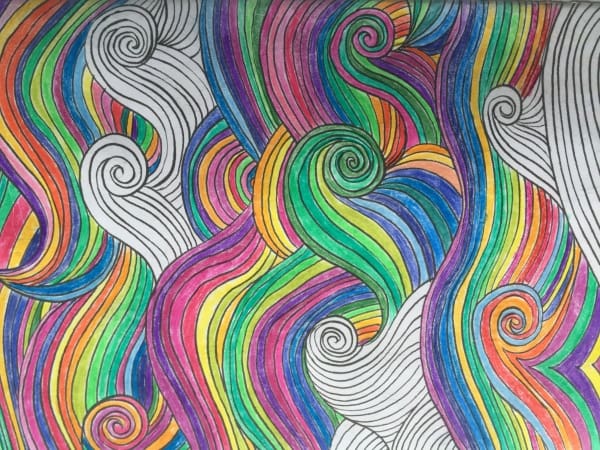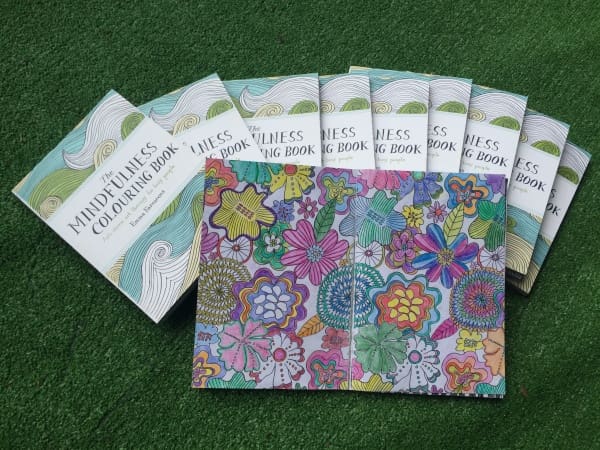Have you been swept up in the colouring craze? It’s been quietly taking over the globe for three years, but it wasn’t until early this year (classic New Zealand) that it hit our shores.
Colouring might just be one of those rare trends with a bit of substance behind it. Research on the benefits of colouring is in its infancy, but early results are promising, suggesting that 20 minutes spent colouring can decrease stress and anxiety. However, I’m most interested in the research that says colouring may be one way you can practise mindfulness.
I know the benefits of mindfulness, but I’m not very good at practising it, so when I saw The Mindfulness Colouring Book by Emma Farrarons at Whitcoulls, inviting me to colour my way into peace and calm, I bit the bullet, purchased it with a pack of coloured pencils and took it home to see if I could finally start reaping some of the benefits of mindfulness.
It didn’t start well.
Did I do something to personally offend you, Emma Farrarons, I thought, viciously stabbing at the page with a purple pencil, because this colouring book seems purposely designed to enrage me. The flowers on the first page aren’t symmetrical, you see. I was angered beyond reason.
I was quite tempted to give up, but almost against my will, I found myself being drawn day after day back to the table to sit down and colour in for a few minutes, and slowly, discovered that it allowed me to switch my whirring brain off just enough to calm down and relax.
Relax and unwind
Once I let go of my need to achieve perfection, colouring became relaxing, a way to unwind at the end of the day. So the flowers weren’t symmetrical – they were unpredictable, but so (at the risk of sounding profoundly cheesy) is life, and I just have to do the best I can. My dad begged me not to tell anyone how I was spending my evenings; my sister showed all her cool London friends my amateur art and enjoyed a great laugh at my expense, but I told them both they were on the wrong side of history and nobly coloured on.
Colouring in has given me a lot of insight into the ways I unconsciously trip myself up every day. Once I started paying attention to my thoughts, I realised I get so caught up worrying what people would think of my colour choices, or inability to stay quite within the lines that I forgot that literally nobody cared except me, and no one has ever looked at my colouring book and demanded to know what I was thinking. I realised I’m really critical of myself, but I can choose to be kinder, to give myself a break and not hold onto things that aren’t important.
Friends sent me photos of their colouring books, all tastefully decorated in natural colours, and I looked at my own garish rainbows with regret and embarrassment. But I like rainbows. I like loud colours and bold strokes – they make me happy! So I continued to ignore the browns and beiges, and wore my bright green and purple pencils into stubs.
Stop unhelpful thoughts
With practice, I learned one of the great lessons of mindfulness: it’s not about turning your brain off, it’s not about stopping the unhelpful thoughts or weird ideas that we all have – it’s about choosing which thoughts to attend to, and which to simply let go. It’s about being kind to yourself, and just being in the present moment, without worry or distraction. It’s actually quite a nice state to be in. I had some great ideas while I was colouring, and I took to jotting them down in a notebook I kept beside me so I could get back to the task at hand.
I sound like an insufferable zealot, and I was still unsure if what I was doing was actually good for me, or if I was simply being taken in by the illusion of health. So I email Grant Rix, Mindful Aotearoa Operations Manager, and ask if colouring in can really be a way of practising mindfulness.
“That is something only you can answer,” he says, helpfully. “When you were colouring, were you present for what you were doing and with a sense of openness and curiosity about the exercise? If so, then yes that quality of attention is mindfulness. The book itself is just a book, which in this instance may have helped to foster some mindfulness.”
Mindfulness it is, then.
Of course, nothing can replace the benefit of learning mindfulness from an experienced teacher, someone who can guide you toward maintaining mindful thinking even when you’re not colouring in teacups or owls or waves. A teacher can help you to cope when the present moment is less than pleasant, and reap more benefits from mindfulness practice. But I found that this book was a great start, opening the door toward deeper practice for me, and I truly enjoy the time I spend colouring in its pages.
By Sophia Graham, Communications & PR Specialist, Mental Health Foundation


